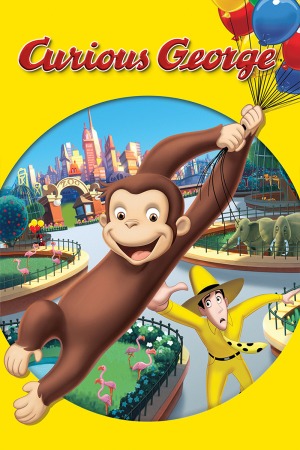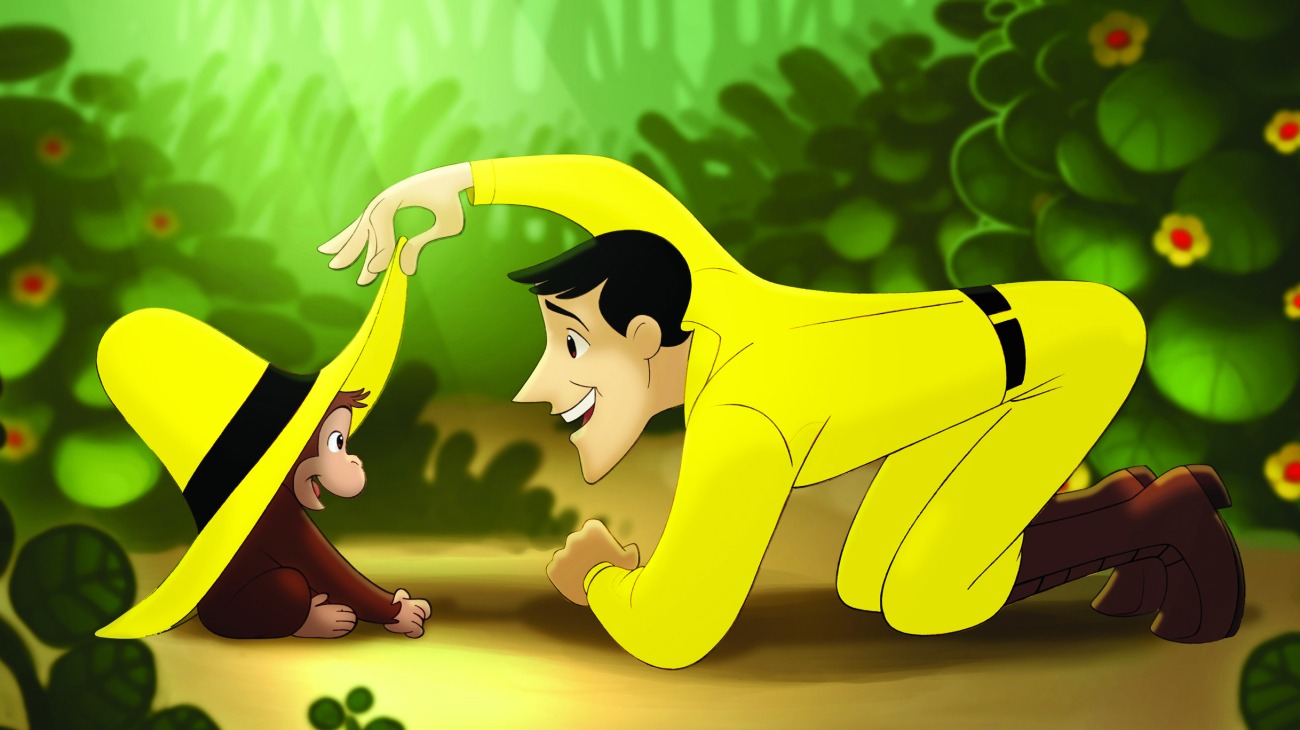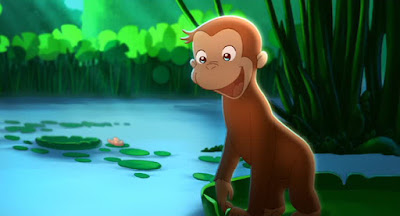
The curious little monkey
A review requested by Kari Johnson, with thanks for contributing to the Second Quinquennial Antagony & Ecstasy ACS Fundraiser.
You have to hold it just right, but Curious George is sort of the exact moment that traditional animation died in the American studio system. There have been only four theatrically-released studio features animated in a traditional aesthetic style since Universal dropped the movie indifferently into the world in February, 2006, and every one of them comes with an asterisk: 2009's The Princess and the Frog and 2011's Winnie the Pooh were both essentially boutique products made by Disney, a company that openly tries to dictate rather than follow market realities;The Simpsons Movie in 2007 was, well, The Simpsons Movie, and beholden to an entirely unique audience; 2015's The SpongeBob Movie: Sponge Out of Water, though primarily traditional animation, was heavily marketed to seem like a mostly CGI/live-action production. None of these four films entered the marketplace in anything like the same way Curious George did, in the wholly guileless belief that there was still an audience for traditional animation, albeit an audience of the extremely young and their parents. For its optimism, the film managed to not humiliate itself at the box office, and not a whole lot more.
Now, the danger in putting a movie like this in front of a classic American animation junkie like me is that Curious George much too easily invites "they used to it so much better! why do we live in such ghastly & depraved times! &c." rhetoric that does nobody any good. But there's little point in pretending that it's not exactly what it is: a movie that exists completely at odds to everything in the mainstream of family entertainment as it was practiced in the mid-'00s, which is much the same as it's practiced now, only with slightly less pop culture riffing. A mere two years after Shrek 2 landed on the animation marketplace like a bomb, this wasn't merely a throwback, it was something like an act of war, if a movie with such a profoundly gentle attitude can reasonably described as "warlike". The steady, pleasant story by Ken Kaufman and Mike Werb, adapting the iconic children's books by husband-and-wife illustrator-authors H.A. and Margret Rey nods its head to the greater world of animation storytelling as it existed at that point in time only in that it involves a kind of stupidly convoluted backstory to drive the action, involving concepts that feel a bit more elevated than the film's apparent target audience is likely to cotton to (will the old natural history museum turn into a parking garage, or can the heroes come up with a new exhibit to draw in big crowds in time?). But it has an almost Miyazakian calmness in keeping its stakes down to a nice slow boil, even going so far as to turn its antagonist into a sad, pitiable figure before the halfway mark.
It's an origin story, in which museum employee Ted (Will Ferrell) enthusiastically pitches himself into the mission of finding the lost shrine of Zagawa, home to an enormous ruby statue of an ape, in order to keep the Bloomsberry Museum solvent. For otherwise, the kind science nut Mr. Bloomsberry (Dick Van Dyke, in the first and far sweeter of his 2006 museum-related roles - Night at the Museum hulks in the future like a nascent canker sore) will be helpless to prevent his resentful son (David Cross, whose character has been designed to look unnervingly like him) from tearing the place down. Bloomsberry fils is able to sabotage Ted's trip enough that the explorer only finds a three-inch statue that guides the way to the actual shrine, but he also stumbles across a deeply inquisitive monkey (vocalised by the inimitable Frank Welker), who sneaks along back to the boat behind this strange lanky man all in yellow (Ted was tricked into buying surplus yellow khaki hiking clothes, to bring him in line as the Man with the Yellow Hat, the nameless character's designation in the books). Ted is at first anguished by how badly the monkey, eventually named George by the enthusiastic children under the care of the kind schoolteacher Maggie (Drew Barrymore), messes up his life, but the instant that he finally packs the simian off with animal control, he realises how much more enjoyable things were with that tiny bit of chaos. As one will. Also, the museum is razed and Mr. Bloomsberry is sent to a nursing home, babbling and senescent. Of course not! Unpredictable plotting is so low on Curious George's list of priorities that there's not even a number for it.
It takes a lot to sand the edges off of profoundly harmless source material, but Curious George does manage to be even less threatening than the books ever were; George has been changed from a playfully naughty little scamp to en embodiment of pure, untroubled innocence, so guileless that his rule-breaking only ever manages to charm his victims. Ted has dropped from being a stable adult presence to just a big kid, hideously shy around an very cute, obviously interested girl, and easily bruised by setbacks. It is a very soft movie, Curious George is, which turns out to be greatly appealing in the execution; there is not a trace of mania even when it takes its Pixarian turn into a chase, of sorts, around a city. The jokes are a bit dry and ironic, but never very difficult, and never too funny, in the sense that it expects a boisterous reaction. Director Matthew O'Callaghan is certain looking to amuse his audience, but not to whip us up; Curious George is as soothing as a fleece blanket and cup of tea on a rainy day.
I say that entirely from an adult's perspective: for all I know, actual children out in the world would find this maddeningly slow and low-impact, and that's part of why it has almost completely disappeared from any kind of cultural dialogue in less than a decade - hell, less than a couple of years. But it can be nice to watching something that pursues quiet and simplicity as a distinctive choice and not just a fallback from laziness - this is an immensely well-crafted movie, especially as a piece of animation, including use of color and and light that absolutely shame Disney's traditional animation death rattle from the handful of years preceding. Not, I hasten to point out, the actual character animation; the humans in the film are so simple that they start to lose definition. Nor in the effects, which are satisfactory without being terribly far-reaching or complicated (there are aerial shots of the crowded city that look several years behind the technological curve). But it's a beautiful movie in pastel and primary tones, with everything feeling covered by an almost indecipherable layer of fuzz. This, for example, is the ending position of the film's opening shot, and our first good look at the protagonist:
As opening mission statements go, that's a pretty clear one: you are about to embark on a movie that goes just a lightly diffuse as it hits your eyes, where nothing is indistinct, but even less so is anything particularly sharp. Also, the main character is boundlessly happy, like, always.
The results aren't perfect; owing mainly to a George-less first act (after an opening scene that functions as a prologue) that takes too much time being goofy and shrill about setting up the plot and human characters, all of whom are some kind of stereotype, but only sometimes obvious or reductive ones. The fate of a museum is a fine plot hook, but it didn't need to be set up in such detail, or with so much concern over Ted's whole deal. And the voices don't, in general, fit the faces - Ferrell disappears into his part, but Van Dyke, Barrymore, and Eugene Levy all significantly do not, and the presence of their characters tends to upset the movie's low key energy.
And really, the storytelling throughout is kind of strained: the movie constantly pulls itself between the states of "this is sweet and gentle and just about being in the moment" and "look at the gimcracks and silliness!", and the more it forgets about that damn parking garage, and the more it just watches Ted and George interacting, the more rewarding it is. So overall it's a touch lumpy, unsure of how patient it can honestly expect its audience to be; but it absolutely never panders, and it's lovely to look at for literally every frame of its running time, even with the "eh" level of the CG elements. I'm not sure if it deserves to be the childhood classic that it surely never shall become, but it's nice to have something this sincere and comforting out in the world, to be enjoyed by whatever small and self-selecting audience has the good fortune to stumble across it.
You have to hold it just right, but Curious George is sort of the exact moment that traditional animation died in the American studio system. There have been only four theatrically-released studio features animated in a traditional aesthetic style since Universal dropped the movie indifferently into the world in February, 2006, and every one of them comes with an asterisk: 2009's The Princess and the Frog and 2011's Winnie the Pooh were both essentially boutique products made by Disney, a company that openly tries to dictate rather than follow market realities;The Simpsons Movie in 2007 was, well, The Simpsons Movie, and beholden to an entirely unique audience; 2015's The SpongeBob Movie: Sponge Out of Water, though primarily traditional animation, was heavily marketed to seem like a mostly CGI/live-action production. None of these four films entered the marketplace in anything like the same way Curious George did, in the wholly guileless belief that there was still an audience for traditional animation, albeit an audience of the extremely young and their parents. For its optimism, the film managed to not humiliate itself at the box office, and not a whole lot more.
Now, the danger in putting a movie like this in front of a classic American animation junkie like me is that Curious George much too easily invites "they used to it so much better! why do we live in such ghastly & depraved times! &c." rhetoric that does nobody any good. But there's little point in pretending that it's not exactly what it is: a movie that exists completely at odds to everything in the mainstream of family entertainment as it was practiced in the mid-'00s, which is much the same as it's practiced now, only with slightly less pop culture riffing. A mere two years after Shrek 2 landed on the animation marketplace like a bomb, this wasn't merely a throwback, it was something like an act of war, if a movie with such a profoundly gentle attitude can reasonably described as "warlike". The steady, pleasant story by Ken Kaufman and Mike Werb, adapting the iconic children's books by husband-and-wife illustrator-authors H.A. and Margret Rey nods its head to the greater world of animation storytelling as it existed at that point in time only in that it involves a kind of stupidly convoluted backstory to drive the action, involving concepts that feel a bit more elevated than the film's apparent target audience is likely to cotton to (will the old natural history museum turn into a parking garage, or can the heroes come up with a new exhibit to draw in big crowds in time?). But it has an almost Miyazakian calmness in keeping its stakes down to a nice slow boil, even going so far as to turn its antagonist into a sad, pitiable figure before the halfway mark.
It's an origin story, in which museum employee Ted (Will Ferrell) enthusiastically pitches himself into the mission of finding the lost shrine of Zagawa, home to an enormous ruby statue of an ape, in order to keep the Bloomsberry Museum solvent. For otherwise, the kind science nut Mr. Bloomsberry (Dick Van Dyke, in the first and far sweeter of his 2006 museum-related roles - Night at the Museum hulks in the future like a nascent canker sore) will be helpless to prevent his resentful son (David Cross, whose character has been designed to look unnervingly like him) from tearing the place down. Bloomsberry fils is able to sabotage Ted's trip enough that the explorer only finds a three-inch statue that guides the way to the actual shrine, but he also stumbles across a deeply inquisitive monkey (vocalised by the inimitable Frank Welker), who sneaks along back to the boat behind this strange lanky man all in yellow (Ted was tricked into buying surplus yellow khaki hiking clothes, to bring him in line as the Man with the Yellow Hat, the nameless character's designation in the books). Ted is at first anguished by how badly the monkey, eventually named George by the enthusiastic children under the care of the kind schoolteacher Maggie (Drew Barrymore), messes up his life, but the instant that he finally packs the simian off with animal control, he realises how much more enjoyable things were with that tiny bit of chaos. As one will. Also, the museum is razed and Mr. Bloomsberry is sent to a nursing home, babbling and senescent. Of course not! Unpredictable plotting is so low on Curious George's list of priorities that there's not even a number for it.
It takes a lot to sand the edges off of profoundly harmless source material, but Curious George does manage to be even less threatening than the books ever were; George has been changed from a playfully naughty little scamp to en embodiment of pure, untroubled innocence, so guileless that his rule-breaking only ever manages to charm his victims. Ted has dropped from being a stable adult presence to just a big kid, hideously shy around an very cute, obviously interested girl, and easily bruised by setbacks. It is a very soft movie, Curious George is, which turns out to be greatly appealing in the execution; there is not a trace of mania even when it takes its Pixarian turn into a chase, of sorts, around a city. The jokes are a bit dry and ironic, but never very difficult, and never too funny, in the sense that it expects a boisterous reaction. Director Matthew O'Callaghan is certain looking to amuse his audience, but not to whip us up; Curious George is as soothing as a fleece blanket and cup of tea on a rainy day.
I say that entirely from an adult's perspective: for all I know, actual children out in the world would find this maddeningly slow and low-impact, and that's part of why it has almost completely disappeared from any kind of cultural dialogue in less than a decade - hell, less than a couple of years. But it can be nice to watching something that pursues quiet and simplicity as a distinctive choice and not just a fallback from laziness - this is an immensely well-crafted movie, especially as a piece of animation, including use of color and and light that absolutely shame Disney's traditional animation death rattle from the handful of years preceding. Not, I hasten to point out, the actual character animation; the humans in the film are so simple that they start to lose definition. Nor in the effects, which are satisfactory without being terribly far-reaching or complicated (there are aerial shots of the crowded city that look several years behind the technological curve). But it's a beautiful movie in pastel and primary tones, with everything feeling covered by an almost indecipherable layer of fuzz. This, for example, is the ending position of the film's opening shot, and our first good look at the protagonist:
As opening mission statements go, that's a pretty clear one: you are about to embark on a movie that goes just a lightly diffuse as it hits your eyes, where nothing is indistinct, but even less so is anything particularly sharp. Also, the main character is boundlessly happy, like, always.
The results aren't perfect; owing mainly to a George-less first act (after an opening scene that functions as a prologue) that takes too much time being goofy and shrill about setting up the plot and human characters, all of whom are some kind of stereotype, but only sometimes obvious or reductive ones. The fate of a museum is a fine plot hook, but it didn't need to be set up in such detail, or with so much concern over Ted's whole deal. And the voices don't, in general, fit the faces - Ferrell disappears into his part, but Van Dyke, Barrymore, and Eugene Levy all significantly do not, and the presence of their characters tends to upset the movie's low key energy.
And really, the storytelling throughout is kind of strained: the movie constantly pulls itself between the states of "this is sweet and gentle and just about being in the moment" and "look at the gimcracks and silliness!", and the more it forgets about that damn parking garage, and the more it just watches Ted and George interacting, the more rewarding it is. So overall it's a touch lumpy, unsure of how patient it can honestly expect its audience to be; but it absolutely never panders, and it's lovely to look at for literally every frame of its running time, even with the "eh" level of the CG elements. I'm not sure if it deserves to be the childhood classic that it surely never shall become, but it's nice to have something this sincere and comforting out in the world, to be enjoyed by whatever small and self-selecting audience has the good fortune to stumble across it.







